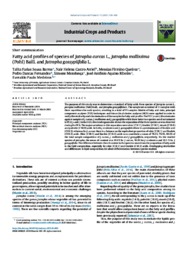Fatty acid profiles of species of Jatropha curcas L., Jatropha mollissima (Pohl) Baill. and Jatropha gossypiifolia L.
Fatty acid profiles of species of Jatropha curcas L., Jatropha mollissima (Pohl) Baill. and Jatropha gossypiifolia L.
Author(s): BARROS, T. F. S.; ARRIEL, N. H. C.; QUEIROZ, M. F.; FERNANDES, P. D.; MENDONCA, S.; RIBEIRO, J. A. de A.; MEDEIROS, E. de A.
Summary: The purpose of this study was to determine a standard of fatty acids from species of Jatropha curcas L., Jatropha mollissima (Pohl) Baill., and Jatropha gossypiifolia L. The sample set consisted of 11 samples with three repetitions for each species, resulting in a total of 99 samples. Matrix of fatty acid data, principal component analyses (PCA) techniques and hierarchical cluster analyses (HCA) were applied in order to verify the similarity and discrimination of the samples for fatty acid profile. The PC1 (x-axis) discriminates against samples of J. curcas, J. mollissima and J. gossypiifolia while these latter two species are discriminated in PC2 (y-axis). In the HCA, the dendrogram also shows the separation of the three species as was observed during the PCA. The major variations in this separation were oleic (C18:1), linoleic (C18:2), stearic (C18:0) and palmitic (C16:0) acids. In both J. mollissima and J. gossypiifolia there is a predominance of linoleic acid (C18:2), whereas for J. curcas there is a balance on the equivalent proportion of oleic (C18:1) and linoleic (C18:2) acids. Oleic (C18:1) and linoleic (C18:2) acids sum constitute a mean of 76.5%, 78.5%, 84.5% of the total sample composition of J. curcas, J. mollissima and J. gossypiifolia, respectively. For the studied species of Jatropha, the mean oil content was 35.0% for J. curcas, 18.3% for J. mollissima and 22.1 % for J. gossypiifolia. The difference between the oil content in the species comes from the proportion of fatty acids in the lipid composition, especially for oleic (C18:1) and linoleic (C18:2) acids. Overlapping similarities and differences in lipid composition did allow differentiation between species studied.
Publication year: 2015
Types of publication: Journal article
Unit: Embrapa Cotton
Observation
Some of Embrapa's publications are published as ePub files. To read them, use or download one of the following free software options to your computer or mobile device. Android: Google Play Books; IOS: iBooks; Windows and Linux: Calibre.
Access other publications
Access the Agricultural Research Database (BDPA) to consult Embrapa's full library collection and records.
Visit Embrapa Bookstore to purchase books and other publications sold by Embrapa.

